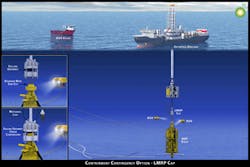May 30, 2010 -- Yesterday, BP issued the determination we've all been dreading: the top kill attempt has ended in failure.
All last week, BP, U.S. officials, and the public pinned their hopes on this latest attempt to stop the flow of oil and gas leaking into the Gulf of Mexico.
After several days of executing the top kill, whereby 30,000 barrels of heavy drilling mud were pumped into the well pipe to overcome the flow of oil, it finally became apparent that it just wasn't working.
Although it reportedly slowed, and perhaps even briefly stopped, the oil flow, the result was temporary. The viscous fluids being pumped into the pipe were not enough to suppress the pressure coming up from the well below.
BP COO Doug Suttles told reporters yesterday, "We have not been able to stop the flow."
With this latest plan, the damaged riser will be removed from the top of the broken blow-out preventer (BOP). A cap will be placed over the cleanly cut pipe at the top of the BOP's LMRP. A riser pipe connected to the cap will capture oil and gas flowing from the well and send it up to the Discoverer Enterprise drillship at the surface, 5,000 feet above.
BP says the LMRP cap is already on site and expects to be able to cap it in about four days.
Some experts have voiced concern that, if this attempt also fails, the flow of oil could increase. Right now, the cinched pipe riser pipe could be restricting the flow of oil somewhat; if the riser pipe is removed and not successfully capped off, they fear that oil and gas will gush unabated and at full velocity.
BP has warned, as it has in every prior attempt to stop the gushing pipe on the bottom of the ocean, that such operations have never been carried out at these depths and that "successful deployment...cannot be assured."
In a statement released yesterday, President Obama said, ..".every day that this leak continues is an assault on the people of the Gulf Coast region, their livelihoods, and the natural bounty that belongs to all of us. It is as enraging as it is heartbreaking, and we will not relent until this leak is contained, until the waters and shores are cleaned up, and until the people unjustly victimized by this manmade disaster are made whole."
The President has ordered several top officials -- EPA Administrator Lisa Jackson, NOAA Administrator Jane Lubchenco, Department of the Interior Secretary Ken Salazar -- to return to the Gulf Coast region this week to oversee response operations.
In the ongoing investigation of this disaster, the Subcommittee on Oversight and Investigations will hold a field hearing on Monday, June 7, 2010, in Chalmette, Louisiana. The hearing will examine the impact of the oil spill on the Gulf region.
Perhaps a small bit of good news this week: the Senate has passed the Disaster Relief and Summer Jobs Act of 2010, which contained two amendments that could soon release funds to help with the cleanup of Louisiana's damaged wetlands.
The first amendment would expedite the distribution of previously appropriated coastal restoration funding to provide emergency cleanup assistance. The other amendment would authorize the U.S. Army Corps of Engineers to use dredged material from waterways in the Gulf Coast to bolster barrier islands and restore wetlands.
The House has not yet voted on the legislation.
Estimates vary regarding the amount of oil being spewed into waters off the coast of Louisiana. Last week, Incident Command's Flow Rate Technical Group -- a committee tasked with providing a more accurate estimate of the flow rate of the oil -- released its findings.
After using three separate calculation methodologies, the FRTG determined that the actual flow rate is in the range of 12,000 to 19,000 barrels per day. That's more than three times BP's original estimates of 5,000 barrels per day.
Using the new figures, somewhere between 500,000 and 800,000 gallons of oil have spilled out each day since the tragic explosion on April 20.
Totaling somewhere between 20 and 30 million gallons, and covering an estimated 30,000 square miles, it's officially the worst oil spill disaster in U.S. history.
Related Articles
BP oil spill: Top kill delayed, patience wears thin >
BP oil spill: Slick enters Louisiana wetlands, loop current >
BP oil spill: Tar balls found on Keys shoreline not linked to Deepwater Horizon >
BP oil spill: Some oil could enter loop current; Fishery closures in gulf waters to expand >
BP oil spill: Siphon now working, collecting 'some' oil; Concerns turn toward 'loop current' >
BP oil spill: Setback in attempt to siphon oil from gulf waters, engineers will try again >
BP oil spill: Cleanup battle rages on in waters of Gulf of Mexico >
BP oil spill: Update on cleanup of gulf waters, underwater video released>
BP oil spill: Clean up of gulf waters continues >
BP oil spill: Measures to mitigate wetland damage, stem flow ...>
BP oil spill: Clean-up attempt fails, wetlands under grave threat >
###




